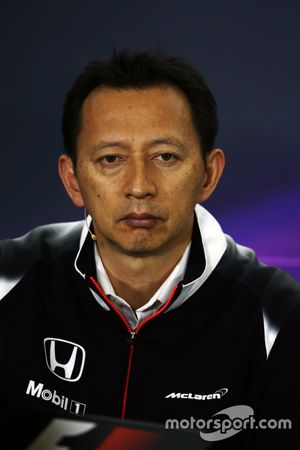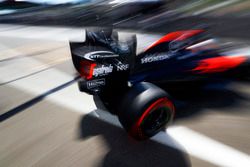Interview: Why Honda's risk-taking attitude brings promise
Fernando Alonso said recently that the true sign of Honda's Formula 1 progress did not emerge with recent attention-grabbing performances, but instead will be revealed on tracks like Singapore this weekend.

Photo by: McLaren





















For when the Spaniard suggested that his team had the potential to slot in behind Red Bull, it certainly made people sit up and take notice of how far Honda has come in 12 months.
After a disappointing first year back in F1 for the Japanese car manufacturer, the project has been much improved, although it is still not at a level that has left its bosses completely satisfied.
But what has changed is a belief that the foundations are set for a much better future, with areas of weakness addressed, relations with McLaren significantly better and the potential for all-new design concepts with its 2017 engine.
One thing perhaps says more than anything about how Honda's attitude and inner-belief has come on in understanding what it needs to do to make a fight of it in F1.
It is that it is no longer happy to sit back and play safe for fear of losing face. Instead it is willing to take risks in the pursuit of performance.
For Honda's F1 project leader Yusuke Hasegawa reveals that recent reliability woes were caused not by design or manufacturing mistakes, but instead because it was willing to push the boundaries in it quest for performance.
"Maybe I can explain," he says, when asked about why Honda's reliability had not been so strong recently.
"At the winter tests, we were thinking our car performance was not bad to get points. So I decided to start the season with very marginal [performance] settings so reliability would be the first priority for us.
"But after the Chinese GP, where we finished 12th and 13th, and everybody finished the race, I understood that just finishing the race meant we wouldn't get anything. So we had to take some risks.
"So from Russia we started to use higher ignition settings and higher performance settings, and it was directly related to some problems with the engines. But I understood we had to take some risks.
"That increased some issues unfortunately and also at Spa it was the same thing. We needed higher performance, which is why we introduced the new Spec 3 engine, but we didn't have enough time to set up and tune and check. So that made us have so many issues over Spa/Monza. But it is what we needed to do."
More to come
It was obvious after 2015 that Honda needed to make big improvements, as well as get more realistic about what was achievable in the short term.
Its pre-season target of regular Q3 and getting points has nearly been achieved, with Hasegawa backing up claims from Toro Rosso's Carlos Sainz that it has halved the gap between the 2015 and 2016 Ferrari engines this year.
"Yes, I think so," he said. "It is also natural because we were starting far behind.
"But we had to catch up much quicker than other teams. So as a ratio of the performance gains, of course it is faster. But once we get closer, then from that point on it becomes difficult to get even closer."
Interestingly, Hasegawa does not believe that he has increased Honda's rate of progress in F1 since its return this year – as he thinks last year's efforts were hidden by poor reliability.
"Last year it was very difficult to evaluate the progress because reliability was the biggest issue. And also they couldn't score points consistently, so it was difficult to see their progress.
"But from a power unit point of view they were improving their performance. So from that point, the ratio of improvement wasn't a big difference. I think we are proud to keep the same level of improvement from last year to this year."
What has changed
One of the biggest differences from last year to this season is a much closer relationship with McLaren.
At times throughout 2015, the strains were clear as the two organisations struggled to understand what each other needed and how best to operate together.
Now, the communication channels are working well, with racing director Eric Boullier making a point of regular trips to Japan to keep an eye on progress.
There has also been an acceptance from Honda's quarters that asking for help in certain areas was not a sign of weakness but actually proof that that it wanted success.
Hasegawa added: "I think the relationship is getting better although it is natural because it is the second year. Because of that we can introduce some of their technology from them.
"One of the things is the induction box – we asked them to design and asked them to produce it. They have a huge good factory for the carbon manufacturing, so it makes sense to ask them.
"I don't know exactly what they were doing last year, but with the communication and conversation we decided to operate closely – and it is fluid I think. We speak many times, as a team. There is no line [that separates] Honda and McLaren."
2017 clean sheet
While there remains little scope for much more improvement from the power unit over the course of this season, with only one more upgrade likely, what will be interesting will be just how different its 2017 project will be.
For the scope to make radical change is greater thanks to the agreement of F1's engine manufacturers to scrap the token system and the black boxes areas of fixed designs that have been in place since 2014.
Hasegawa will not reveal too many details about what Honda is working on right now, but he is clear that the main focus will be on improving the internal combustion element.
"For next year, without tokens we can completely redesign the engine inside the regulations. So we started our combustion chamber and packaging from the zero point," he said. "The combustion and the ICE will be the biggest difference."
It is accepted that much of Renault and Ferrari's progress this year has been thanks to adopting the jet technology concept that has helped Mercedes achieve so much success in the turbo-hybrid era.
There have long been rumours that Honda has been working on a similar concept with fuel partner ExxonMobil for introduction in 2017.
It was something that Hasegawa would not confirm when asked, but equally he did not dismiss it.
"I won't disclose it, because it is a key area," he said. "Of course we research every possibility, but I don't want to tell exactly what we will introduce."
So what about the infamous 'size zero' concept of a very small package?
"We cannot disclose the complete package right now but the name of the engine – the size zero – all engines need to be smaller as a package. So we don't want to give up the name of 'size zero'. But of course we will repackage.
"But it is difficult to say what is different...we modified many areas but difficult to say if it is a completely different engine."
Hasegawa gives the impression that Honda's F1 programme is well prepared for the battles ahead. But he is not yet willing to make any bold promises of what it expects to achieve on track in 2017.
When asked if it was fair to say Honda was confident about its potential for next year, he said: "It is difficult. If so, I would be very happy to tell you...but I'm not sure."
After all, in F1 it is always better to under-promise and over-deliver. For now, Hasegawa is only willing to take the risks out on track.
Be part of Motorsport community
Join the conversationShare Or Save This Story
Subscribe and access Motorsport.com with your ad-blocker.
From Formula 1 to MotoGP we report straight from the paddock because we love our sport, just like you. In order to keep delivering our expert journalism, our website uses advertising. Still, we want to give you the opportunity to enjoy an ad-free and tracker-free website and to continue using your adblocker.























Top Comments